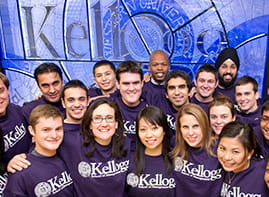Research from Kellogg's Mohan Sawhney takes middle-market companies to the next level
3/10/2014 -
In the second installment of the Kellogg-Chase “Growth in Middle-Market Companies” series, Kellogg Professor Mohan Sawhney highlights five strategic areas where executives must shift their mindset to achieve scale.
As every middle-market executive can attest, maintaining a steady growth trajectory is a formidable challenge. Business leaders who understand and recognize the impediments to growth can assess their organization and identify areas where they are falling short. To jump-start growth, companies must often shift their mindset to embrace growth and add the capabilities to pursue expansion. Middle-market companies that instill a culture of innovation can create new products and services that can drive growth.
The paradox of growth strategy
While it’s tempting to view business growth as a smooth, linear path, the reality is much more complicated. Often, the initial strengths and skills that fuel a company’s ascent can actually become obstacles in getting it to the next level. A startup may find it difficult to maintain its passion and agility once more formal structure is in place. Similarly, if an organization has been driven by a founder’s personal relationships, growth will be constrained when it attempts to scale.
Rapid expansion is often followed by plateaus of slow, incremental progress. Most companies experience punctuated equilibrium, where their strengths and capabilities combine to achieve impressive growth. During the ensuing periods of discontinuity, executives must reassess their strategy and chart a new path. As the exhibit illustrates, every company—from startups to Fortune 500 corporations—experiences these disruptions.
A number of organizational barriers—from a shortage of bench strength, professional management expertise and systematic processes to an anemic sales pipeline—can cause growth to stall. The organic nature of early-stage growth can often leave companies relying on a handful of talented leaders to handle everything from acquiring new clients to managing functions in an informal, reactive way. Once a company achieves a certain size, the needs of the business typically overwhelm these ad hoc approaches.
To reach the next stage of growth, executives must engage in a continual cycle of reinvention. Paradoxically, the initial strategies that fuel a company’s ascent can actually become obstacles in getting it to the next level. Indeed, middle-market executives will find that every inflection point in their company’s development will bring new challenges that require a different set of organizational capabilities.
Building organizations to scale
To take their company to the next level, middle-market companies need to navigate five transitions to ensure that the company is “built to scale”:
- Opportunistic to Strategic. In the early growth phase, companies need to “probe and learn” to find the sweet spot in markets, customers and products. While this approach can pay dividends initially, it can quickly leave companies spread too thin. As companies grow, they need to reign in opportunism and become more strategic in the opportunities they pursue. Executives should seek to narrow their markets and focus on targeted customer segments. Although it seems counterintuitive, middle-market executives will be able to increase revenues by narrowing the number of markets and making fewer, bigger—and bolder—bets.
- Projects to Products. With project-based work, a company can learn at the client’s expense while gaining vital experience, services-based revenues and a better understanding of market opportunities. However, since services are people-intensive, they don’t scale nonlinearly. To fuel sustained growth, companies must translate project-based work into scalable products and develop different business models. Executives should seek to identify patterns in the delivery of services and then design products based on what can be repeated. Adobe, for example, has achieved high margins by using its experience in serving customers to develop solutions that facilitate common business tasks.
- Ownership to Partnership. To satisfy and understand customers, startups typically seek to control every facet of operations—such as sales channels, supply chains and product development. But to scale, middle-market companies should tap partnerships to access capabilities, technology, and customers. These partnerships fall into two categories: market access, whereby a company can reach potential customers through the direct channels that its partners offer; and capability access, in which an external party is able to handle a function, such as supply chain management or human resources, at more effectively (and often at lower cost) than the company could on its own. The benefit of these arrangements is that they free executives to focus on their core areas of expertise without being distracted or constrained by operational limitations.
- People to Process. In most startups, a handful of talented employees are the driving force. When this core team can’t scale, the shortage of talent can quickly become an impediment to expansion. As a result, executives need to embed expertise into the company’s processes and structure to lessen its reliance on a few key people. Core functions―such as strategic planning, sales and client management, product development and talent attraction and retention―can be improved significantly by implementing processes. To set priorities, executives should systematically look at the enterprise and identify bottlenecks that are holding back operational performance and address them first.
- Relationships to Brands. In the early stages, companies tend to drive sales through relationships that are built by key rainmakers and their contacts. If key team members depart, organizations lose not only those relationships but also intellectual property and institutional knowledge. Therefore, to reach new customers and markets, companies must build a strong brand that communicates their value to a broader audience. Middle-market companies need to invest in building and promoting their brand as an embodiment of the enterprise’s value proposition. This process involves delinking the brand from relationships while still embodying the critical attributes that the company has delivered in its relationships.
Driving innovation across the company
Beyond the organizational mindset and capabilities to support growth, middle-market companies must also reinvent themselves through innovation. Since innovation can be a loosely applied, catch-all term, it can be instructive to define it in this context: innovation should focus on outcomes (that is, the value it creates or captures), extend beyond product and process innovation and seek to identify new combinations rather than radical redefinition. It’s not about a big departure from the past or simply developing more ideas. Rather, some of the most game-changing innovations of recent years—think the iPod or iPad—offer new combinations of features or functionality that addressed emerging consumer needs.
Companies that excel at innovation take a truly enterprise-wide approach to channeling their energy and resources to develop the most promising ideas. In my experience, innovation can be organized into four main categories, each with three components.
Offerings
- Product. Introducing products and services, such as contingent workforce management and procurement software, that are new or significantly improved with respect to features and performance.
- Platform. Creating a competitive advantage by using modular components, processes and technologies to develop a broad range of new products and services for an installed base of customers and partners (for example, Google with Gmail, Google+ and YouTube as planks).
- Solution. Developing a customized combination of products, services and information to solve an end-to-end customer problem, such as automated mortgage application processing.
Customers
- Customer. Identifying unmet customer needs or underserved customer segments (such as the outsourcing of IT or other functions) and building the capabilities to address them.
- Interaction. Using innovative methods to promote engagement with customers and stakeholders (for example, IBM’s “jams,” which include employees and customers).
- Market communications. Redesigning the interactions that customers have with the company at all touchpoints to increase customer satisfaction and strengthen relationships.
Partnerships
- Ecosystem. Developing innovative partnerships and collaborative relationships with suppliers, partners and resellers to create a joint offering (for example, Coca-Cola’s partnership with McDonald’s).
- Channels. Introducing new channels, routes to markets or innovative points of presence for customers to find and buy products and services (banks now have active branches on Facebook, for instance).
- Supply chain. Introducing new or significantly improved methods for sourcing inputs—such as reverse auctions, direct procurement and e-warehousing—to deliver offerings to the market more efficiently.
Operations
- Process. Implementing new or significantly improved operating processes (manufacturing, sales, finance and human resources, among others) to boost performance and efficiency.
- Value capture. Redefining the way a company makes money by creating new revenue streams and pricing models (for example, Google’s use of APIs to promote the development of mobile apps for Android phones).
- Management. Implementing new organizational structures (such as front-back hybrid, consisting of customer-facing functions segmented by geography and back-office shared services) or management methods to improve efficiency.
The innovation radar offers companies a valuable tool to identify within the organization and direct the necessary resources to develop promising ideas into products and services.
...
For middle-market companies, each new revenue goal requires a reassessment of organizational capabilities and strategies to foster innovation. With the mindset and commitment to innovation, executives will be well-positioned to scale and achieve sustained growth.
Mohan Sawhney is a professor of marketing at the Kellogg School of Management.





